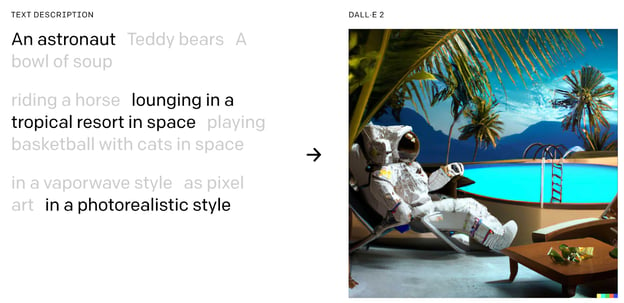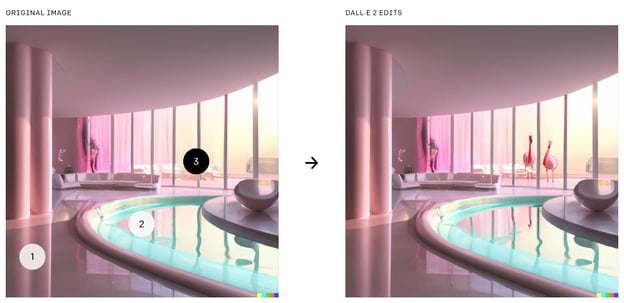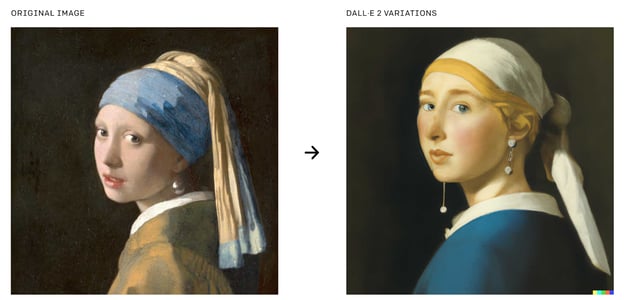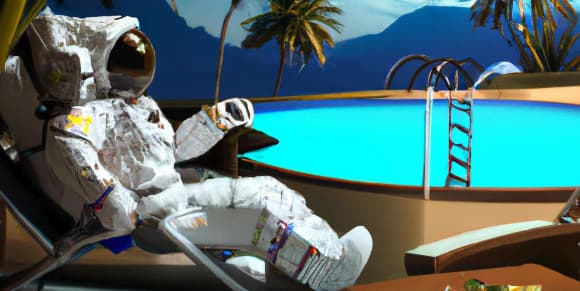DALL-E 2 is a new artificial intelligence system that automatically creates and edits images simply by following natural language instructions you give it.
If that sounds futuristic, it's because it is. DALL-E 2 has taken AI watchers by surprise with its advanced ability to perform the creative work of image creation. It was put best by Sam Altman, CEO of OpenAI, the company that built DALL-E 2:
"A decade ago, the conventional wisdom was that AI would first impact physical labor, and then cognitive labor, and then maybe someday it could do creative work. It now looks like it’s going to go in the opposite order."
That's putting it lightly. DALL-E 2 is a major AI milestone and has huge implications for entire professions and business models.
This post serves a primer on what DALL-E 2 is, what it can do, and why this all matters. It also contains some (hopefully valuable) speculation on how this technology might be used by marketers to transform their work, now that the tool is commercially available.
Let's dive in.
What is DALL-E 2?
DALL-E 2 is an AI system created by OpenAI (of GPT-3 fame) that automatically creates original art and imagery based on natural language prompts.
That means you type in a description, and DALL-E 2 creates a piece of art or an image based on what you type. You can even tell DALL-E 2 to create the image in a specific style. Check out the example below of “An astronaut lounging in a tropical resort in space in a photorealistic style”...

Image Source: OpenAI
You can also tell DALL-E 2, using natural language, to make specific edits to existing images. For instance, you could tell it to “add two flamingos in the background” of a picture—and it will do so automatically.

Image Source: OpenAI
Last, but certainly not least, DALL-E 2 can create a range of original images similar to an existing image you upload. For instance, if you uploaded an image of the famous oil painting “Girl with a Pearl Earring,” DALL-E 2 can create stylistically similar variations…

Image Source: OpenAI
DALL-E 2 is the next evolution of OpenAI’s DALL-E system introduced in 2021. It builds on that system by offering more realistic, accurate image generation with quadruple the resolution. (The name DALL-E is a nod to the artist Salvador Dali and the Pixar movie robot WALL-E.)
When Will DALL-E 2 Be Available?
On July 20, 2022, OpenAI announced that DALL-E 2 is now available in beta. In the weeks following the announcement, OpenAI plans to invite 1 million people from the DALL-E 2 waitlist to use the tool. Importantly, users will retain full commercial rights to the images they create. That means you can use DALL-E 2 images in any use case for your business or product that you dream up.
Will DALL-E 2 Be Free?
To an extent, yes. In the first month after you receive beta access, you get 50 free credits to use to generate images using DALL-E 2. After the first month, you receive 15 free credits each month. One credit will get you four images generated by DALL-E 2 based on a single prompt. Or, you can use one credit to edit or vary a prompt, returning three additional images.
Beyond that, you have to pay for additional credits. OpenAI currently charges $15 for 115 credits. Credits must be bought in 115-credit blocks.
OpenAI also offers financial assistance for artists. You can apply for subsidized access to DALL-E 2 here.
How DALL-E 2 works
DALL-E 2 uses sophisticated deep learning AI called a “generative model” (powered by neural networks) to not only create images from natural language, but also understand the relationships between objects in the image.
In the first example mentioned in the previous section—“An astronaut lounging in a tropical resort in space in a photorealistic style”—DALL-E 2’s image outputs may change, but relationships between all the image’s elements will remain broadly consistent across variations. The astronaut will almost always be lounging in a resort in space in the way we’d expect.
“DALL·E 2 has learned the relationship between images and the text used to describe them. It uses a process called “diffusion,” which starts with a pattern of random dots and gradually alters that pattern towards an image when it recognizes specific aspects of that image.”
This sounds like a technical detail but is actually a big deal. Historically, neural networks like the one used in DALL-E 2 have historically not been good at understanding the relationships between objects.
If you train a neural network to classify ten different dog breeds as "dogs,” you ideally want it to be able to also classify breeds it has never seen before as “dogs,” too. If it does, you can go use this neural network to identify all different types of dogs. If it doesn’t, the neural network isn’t useful outside of the ten breeds you taught it about.
That’s a simplistic example, but the idea is this:
If your neural network can’t generalize its performance to data it’s never seen before; it’s not that useful. You’d have to retrain it constantly, which defeats the purpose of using self-learning AI.
Historically, it’s been very hard to get neural networks to work generally on different tasks. Despite being incredibly powerful, this has made neural networks often useful and valuable only for very limited and specific tasks.
However, DALL-E 2 represents a breakthrough here—at least in the area of image generation.
DALL-E 2 can consistently create different types and styles of images, even when the input (your description) changes. It can be generalized to many types of image creation.
The results speak for themselves…DALL-E 2 can create as many types and styles of images as you can dream up. See some examples below shared by OpenAI.
"a raccoon astronaut with the cosmos reflecting on the glass of his helmet dreaming of the stars"@OpenAI DALL-E 2 pic.twitter.com/HkGDtVlOWX
— Andrew Mayne (@AndrewMayne) April 6, 2022
"A Shiba Inu dog wearing a beret and black turtleneck" #dalle pic.twitter.com/VkAsZsNMhY
— OpenAI (@OpenAI) April 6, 2022
— Sam Altman (@sama) April 6, 2022
Concerns about DALL-E 2
DALL-E 2’s incredible capabilities also make it dangerous. The possibility of generating highly realistic original images could be misused by bad actors to generate fake or offensive content at scale. In fact, this is why OpenAI waited many months to make the tool commercially available.
In those months, OpenAI "worked with researchers, artists, developers, and other users to learn about risks," says the company. Based on that work, OpenAI has laid down some guardrails that govern how the technology may be used. These guardrails include:
- OpenAI rejects image uploads "containing realistic faces and attempts to create the likeness of public figures, including celebrities and prominent political figures." The company also won't let you generate photorealistic faces of real individuals.
- You can't use DALL-E 2 to generate violent, adult, or political content, as well as harmful content in other categories per OpenAI's content policy.
- OpenAI has also "implemented a new technique so that DALL·E generates images of people that more accurately reflect the diversity of the world’s population. This technique is applied at the system level when DALL·E is given a prompt about an individual that does not specify race or gender."
- The company also employs monitoring systems run by humans and machines to police possible misuse.
Why DALL-E 2 matters to marketing and business leaders
DALL-E 2’s capabilities have massive implications for marketers and businesses. For proof, look to OpenAI’s GPT-3 language model.
This groundbreaking natural language generation model began as a research project. It was then opened up for commercial use, which caused an explosion of AI-powered content generation tools. Finally, it was exclusively licensed to Microsoft.
The same is now happening with DALL-E 2. The tool is now commercially available, and we expect some serious opportunities—and disruptions.
Disruption to designers, artists, photographers, and creatives
DALL-E 2 could severely disrupt the work and earning power of many designers, artists, photographers, and visual content creators.
Why do you need to hire an expensive specialist for image creation when DALL-E 2 does it for you? Why do you need a photographer when a machine generates affordable photorealistic images? Why do you need to pay for a Photoshop expert when DALL-E 2 can edit images based on instructions from anyone in your company?
We’re generally very optimistic that AI will create many more jobs and economic opportunities than it destroys. But this is one area where AI may erase jobs. That’s not to say designers, artists, photographers, and creatives will go away. But their current work just got a lot less valuable in the marketplace.
As Sam Altman, OpenAI’s CEO, put it:
“A decade ago, the conventional wisdom was that AI would first impact physical labor, and then cognitive labor, and then maybe someday it could do creative work. It now looks like it’s going to go in the opposite order.”
Bad news for stock photo businesses
If you’re a stock photo business, DALL-E 2 might be your worst enemy. Stock photos already have a reputation as cheesy and inauthentic, but have been a necessary evil for content creators. That changes the moment DALL-E 2 becomes available for commercial use.
What justification would there be to pay for a stock photo license in a world where DALL-E 2 can create any image you want?
Big time and money savings for marketers
It’s not all bad news. DALL-E 2 will likely be great for marketers. Consider how much time and money we spend on:
- Finding (or creating) images for blog posts, websites, ads, and other content
- Generating visual ideas and variations for logos and brand collateral
- Creating visuals for videos and thumbnails
These tasks all become faster and cheaper with machine-assisted image generation. That frees up marketers to focus on higher-value work versus spending hours clicking through pages of stock photos.
Enhanced creativity for businesses
There's even an argument that DALL-E 2 will make many business professionals more creative. Why? Because anyone with an idea for a visual can make it a reality using DALL-E 2. Sam Altman at OpenAI puts this well when he says:
"It’s an example of a world in which good ideas are the limit for what we can do, not specific skills."
8 Ways Marketers Could Use DALL-E 2
It's still early days for DALL-E 2. But marketers need to start thinking now about how to incorporate AI-powered design technology like DALL-E 2 into their work.
Here are a handful of ways we think DALL-E 2 could be valuable to marketer by allowing them to create:
- Unique, compelling images for blog posts, ebooks, videos, and podcast episode listings.
- Unique, compelling images for website pages and landing pages.
- Visuals for digital or print brand collateral used internally and externally.
- Visuals that help describe complex information, products, or services across all digital assets.
- Eye-catching visuals that stand out in advertising creative.
- Mockups to brainstorm branding, campaign ideas, video scripts, or commercials.
- Mockups or final versions of logos.
- Mockups to inspire and guide human designers on more complex visual generation projects.
What other uses do you see for DALL-E 2 in marketing or other areas of business?
Mike Kaput
As Chief Content Officer, Mike Kaput uses content marketing, marketing strategy, and marketing technology to grow and scale traffic, leads, and revenue for Marketing AI Institute. Mike is the co-author of Marketing Artificial Intelligence: AI, Marketing and the Future of Business (Matt Holt Books, 2022). See Mike's full bio.



